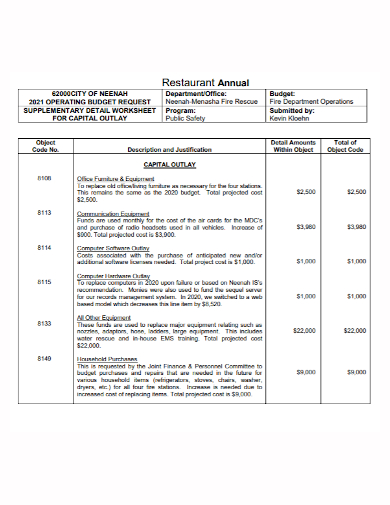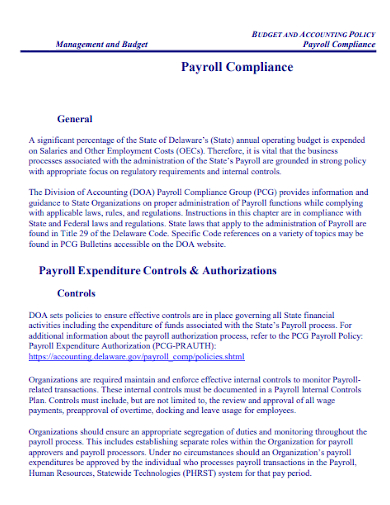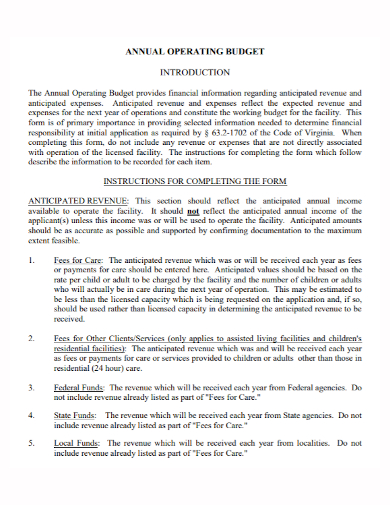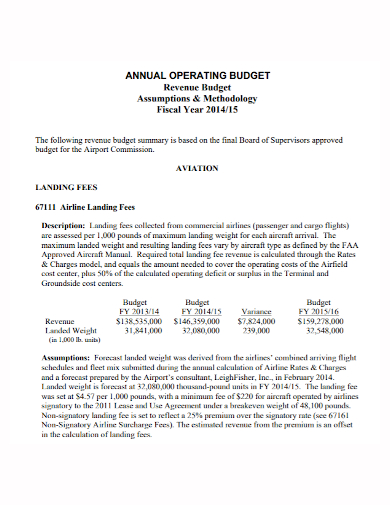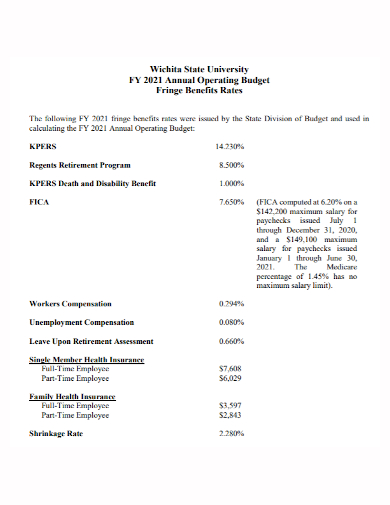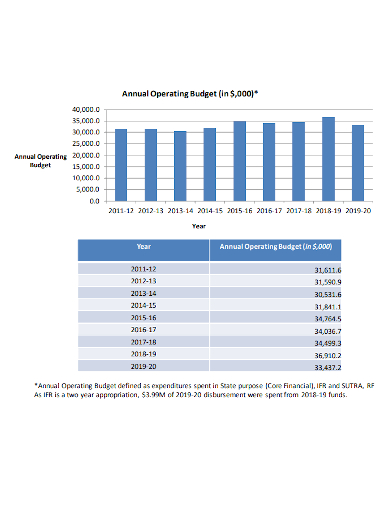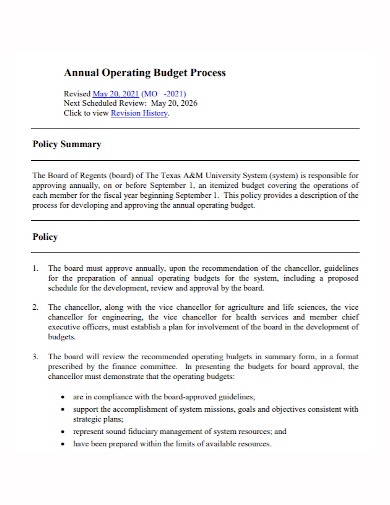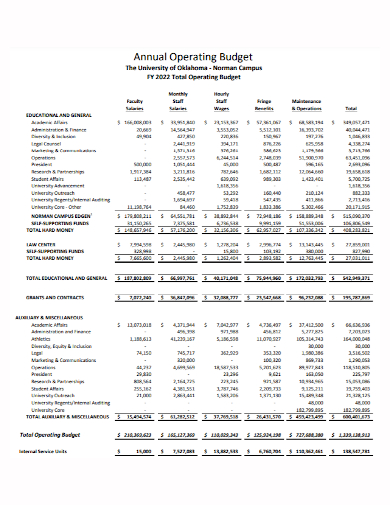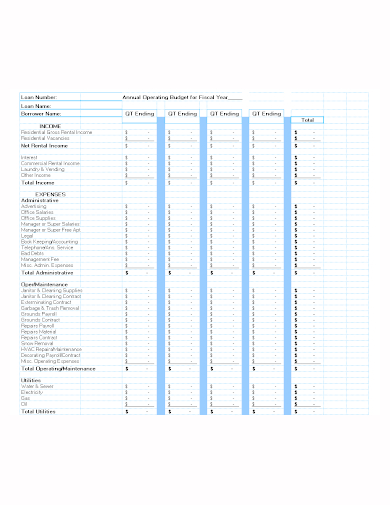An operating budget, which is often presented in income statement format, shows the company’s projected revenue and associated expenses for a future period – usually the next year. Typically, management compiles the budget before the start of each year and then makes monthly updates. An operating budget might include a high-level summary schedule backed up by detail for each budget line item.
10+ Annual Operating Budget Samples
An annual operating budget is a forecast of revenues and expenses for the coming year. It’s one of the most useful tools you’ll ever have. Every water system should carefully complete the annual budget. An operating budget serves as a point of reference for your activities throughout the year and can aid in the management of difficult financial periods, such as when unexpected expenses arise. A new budget must meet three requirements: it must cover a specific time period, in this case, one year. The budget must be defined in terms of its scope, which in this case is operating revenues and expenses. The budget must also be formally documented, usually through the use of electronic worksheets.
1. Annual Operating Budget Template
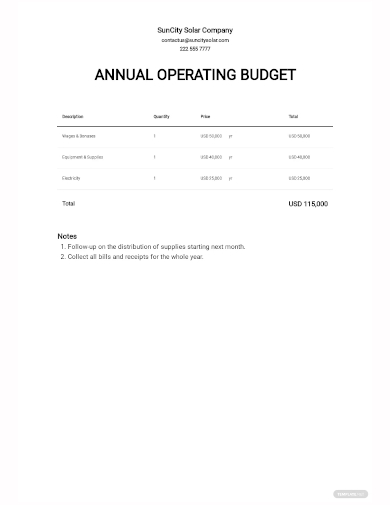
2. Annual Restaurant Operating Budget Worksheet
3. School Annual Operating Budget
4. Annual Operating Payroll Budget
5. Annual Operating Budget
6. Annual Operating Revenue Budget
7. University Annual Operating Budget
8. Sample Annual Operating Budget
9. Annual Operating Budget Policy
10. Campus Annual Operating Budget
11. Annual Operating Budget for Fiscal Year
Components of an Operating Budget
The revenue in an operating budget is shown first, followed by each expense type. This includes variable costs, such as the cost of raw materials and production labor, which fluctuate with sales. Fixed costs are included in the operating budget, such as the monthly rent for office space or the lease payment for a photocopier. Operating expenses, such as interest on business loans, and the non-cash expense of depreciation, are also included in the budget. The company can calculate its projected net income and net profit percentage using these items.
Budget-Assembling Process
Budgeting can be time-consuming, especially in large, complex businesses where the process becomes more detailed. Forward-looking budget numbers are always built on the foundation of previous performance. Accountants typically produce a monthly report after the budget is completed that shows the company’s actual performance for the month, as well as the month’s budgeted numbers, for comparison and analysis.
Try to Get Into the Details
Although creating a high-level budget is efficient, having more detail improves the budget’s relevance and adds value when it is used to guide the company’s financial decisions. Human resources, for example, would put together a detailed budget that includes up-to-date calculations for certain benefits, costs for each new hire, and other details that they deal with on a regular basis. The purchasing department of a company would be the most knowledgeable about the cost of raw materials and issues that affect the accuracy of its budgets, such as price-cut opportunities, seasonal inventory buying costs, or external events that cause inventory prices to fluctuate.
Using the budget versus Using the forecast
The less accurate the information becomes as a company’s budget gets further out. Budgets represent a company’s objective, or where it wants to go with its operations. Companies use forecasting, a tool that is very similar to forecasting, to project the “real” view of where the company is heading. Accountants would then take actual monthly results and forecast the remainder of the year accordingly. This information aids management in deciding on various strategies early in the year so that the company can make changes that will help them meet their budget goals.
FAQs
How to create an annual operating budget?
1. Calculate your total annual operating expenses.
2. Calculate your total annual revenue.
3. Contributions to your reserves should be included.
4. Calculate the year’s expected net revenues.
What are the parts of an operating budget?
- Revenue
- Variable costs
- Fixed costs
- Non-cash expenses
- Non-operating expenses
Be as specific as possible when creating your annual operating budget. It’s best to itemize each expense and source of income so you know exactly where and when the money is going. For all but the smallest organizations, gathering all of the required figures can be a major undertaking. However, it’s necessary for creating a precise operating budget—as well as for enjoying the clarity and guidance this document will provide.
Related Posts
FREE 10+ Annual IT Budget Samples in MS Word | MS Excel | Google Docs | Google Sheets | PDF
FREE 5+ Yearly Budget Planner Samples in PDF | XLS
FREE 10+ Expense Budget Samples in MS Word | Google Docs | Google Sheets | MS Excel | PDF
FREE 4+ Vacation Budget Planner Samples in PDF
FREE 10+ Budget Outline Samples in PDF | MS Word
FREE 10+ Monthly Budget Worksheet Samples in PDF | MS Word | Google Docs | Google Sheets | Excel
FREE 10+ Monthly Project Budget Samples in MS Word | MS Excel | Google Docs | Google Sheets | PDF
FREE 10+ Corporate Budget Samples in MS Word | MS Excel | Google Docs | Google Sheets | PDF
FREE 9+ Primary School Budget Samples in MS Word | Google Docs | Google Sheets | MS Excel | PDF
FREE 10+ Operational Budget Samples in PDF | DOC
FREE 5+ Budget Layout Samples in PDF
FREE 6+ Paycheck Budget Samples in PDF | MS Word
FREE 10+ Architecture Budget Samples in PDF
FREE 10+ Budget Tracker Samples in PDF | DOC
FREE 4+ Corporate Monthly Budget Samples in MS Word | Google Docs | Google Sheets | Excel

